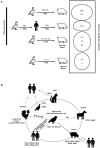Comparative Review of SARS-CoV-2, SARS-CoV, MERS-CoV, and Influenza A Respiratory Viruses
- PMID: 33013925
- PMCID: PMC7516028
- DOI: 10.3389/fimmu.2020.552909
Comparative Review of SARS-CoV-2, SARS-CoV, MERS-CoV, and Influenza A Respiratory Viruses
Abstract
The 2019 novel coronavirus (SARS-CoV-2) pandemic has caused a global health emergency. The outbreak of this virus has raised a number of questions: What is SARS-CoV-2? How transmissible is SARS-CoV-2? How severely affected are patients infected with SARS-CoV-2? What are the risk factors for viral infection? What are the differences between this novel coronavirus and other coronaviruses? To answer these questions, we performed a comparative study of four pathogenic viruses that primarily attack the respiratory system and may cause death, namely, SARS-CoV-2, severe acute respiratory syndrome (SARS-CoV), Middle East respiratory syndrome (MERS-CoV), and influenza A viruses (H1N1 and H3N2 strains). This comparative study provides a critical evaluation of the origin, genomic features, transmission, and pathogenicity of these viruses. Because the coronavirus disease 2019 (COVID-19) pandemic caused by SARS-CoV-2 is ongoing, this evaluation may inform public health administrators and medical experts to aid in curbing the pandemic's progression.
Keywords: COVID-19; MERS-CoV; SARS-CoV; SARS-CoV-2; influenza A virus.
Copyright © 2020 Abdelrahman, Li and Wang.
Figures


References
-
- Jordan D. The Deadliest Flu: The Complete Story of the Discovery and Reconstruction of the 1918 Pandemic Virus. Centers for Disease Control and Prevention, National Center for Immunization and Respiratory Diseases (NCIRD), December 17 (2019). Available online at: https://www.cdc.gov/flu/pandemic-resources/1918-pandemic-h1n1.html (accessed March 19, 2020).
Publication types
MeSH terms
LinkOut - more resources
Full Text Sources
Other Literature Sources
Medical
Miscellaneous

